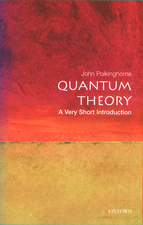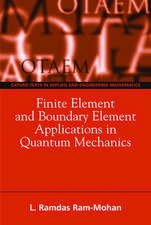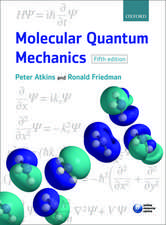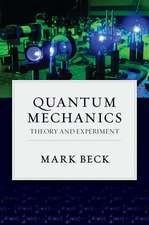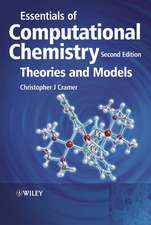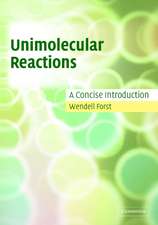The Positive Muon as a Probe in Free Radical Chemistry: Potential and Limitations of the μSR Techniques: Lecture Notes in Chemistry, cartea 49
Autor Emil Roduneren Limba Engleză Paperback – 27 iul 1988
Din seria Lecture Notes in Chemistry
-
 Preț: 96.74 lei
Preț: 96.74 lei - 18%
 Preț: 1123.35 lei
Preț: 1123.35 lei - 18%
 Preț: 776.72 lei
Preț: 776.72 lei - 18%
 Preț: 779.57 lei
Preț: 779.57 lei - 18%
 Preț: 1005.74 lei
Preț: 1005.74 lei - 18%
 Preț: 997.88 lei
Preț: 997.88 lei - 18%
 Preț: 1004.00 lei
Preț: 1004.00 lei - 18%
 Preț: 1136.30 lei
Preț: 1136.30 lei - 18%
 Preț: 1117.03 lei
Preț: 1117.03 lei - 18%
 Preț: 1006.55 lei
Preț: 1006.55 lei - 18%
 Preț: 903.62 lei
Preț: 903.62 lei -
 Preț: 377.73 lei
Preț: 377.73 lei -
 Preț: 395.63 lei
Preț: 395.63 lei - 18%
 Preț: 728.43 lei
Preț: 728.43 lei - 18%
 Preț: 782.57 lei
Preț: 782.57 lei - 18%
 Preț: 1112.78 lei
Preț: 1112.78 lei - 15%
 Preț: 688.13 lei
Preț: 688.13 lei - 15%
 Preț: 646.62 lei
Preț: 646.62 lei -
 Preț: 393.35 lei
Preț: 393.35 lei - 18%
 Preț: 1124.30 lei
Preț: 1124.30 lei -
 Preț: 384.86 lei
Preț: 384.86 lei -
 Preț: 383.71 lei
Preț: 383.71 lei -
 Preț: 378.71 lei
Preț: 378.71 lei -
 Preț: 384.09 lei
Preț: 384.09 lei -
 Preț: 387.42 lei
Preț: 387.42 lei -
 Preț: 388.90 lei
Preț: 388.90 lei -
 Preț: 393.35 lei
Preț: 393.35 lei -
 Preț: 384.09 lei
Preț: 384.09 lei -
 Preț: 377.73 lei
Preț: 377.73 lei -
 Preț: 382.95 lei
Preț: 382.95 lei -
 Preț: 384.70 lei
Preț: 384.70 lei - 15%
 Preț: 644.63 lei
Preț: 644.63 lei -
 Preț: 386.00 lei
Preț: 386.00 lei -
 Preț: 389.70 lei
Preț: 389.70 lei -
 Preț: 384.09 lei
Preț: 384.09 lei -
 Preț: 385.25 lei
Preț: 385.25 lei -
 Preț: 392.21 lei
Preț: 392.21 lei -
 Preț: 386.00 lei
Preț: 386.00 lei -
 Preț: 403.37 lei
Preț: 403.37 lei -
 Preț: 378.71 lei
Preț: 378.71 lei -
 Preț: 383.50 lei
Preț: 383.50 lei -
 Preț: 390.63 lei
Preț: 390.63 lei -
 Preț: 389.31 lei
Preț: 389.31 lei
Preț: 378.71 lei
Nou
Puncte Express: 568
Preț estimativ în valută:
72.46€ • 75.86$ • 59.96£
72.46€ • 75.86$ • 59.96£
Carte tipărită la comandă
Livrare economică 07-21 aprilie
Preluare comenzi: 021 569.72.76
Specificații
ISBN-13: 9783540500216
ISBN-10: 3540500219
Pagini: 116
Ilustrații: VII, 104 p. 1 illus.
Dimensiuni: 170 x 244 x 6 mm
Greutate: 0.2 kg
Ediția:1988
Editura: Springer Berlin, Heidelberg
Colecția Springer
Seria Lecture Notes in Chemistry
Locul publicării:Berlin, Heidelberg, Germany
ISBN-10: 3540500219
Pagini: 116
Ilustrații: VII, 104 p. 1 illus.
Dimensiuni: 170 x 244 x 6 mm
Greutate: 0.2 kg
Ediția:1988
Editura: Springer Berlin, Heidelberg
Colecția Springer
Seria Lecture Notes in Chemistry
Locul publicării:Berlin, Heidelberg, Germany
Public țintă
ResearchCuprins
1 Introduction.- 1.1 Motivation.- 1.2 History and properties of the muon and its bound states.- 1.3 The muon as a probe in matter.- 2 Experiments employing muons.- 2.1 Muon production and decay.- 2.2 The ?SR techniques.- 2.3 Analysis and interpretation of the data.- 3 Theory.- 3.1 Hamiltonians, eigenvectors and energies.- 3.2 Evolution of spin polarization.- 4 The cyclohexadienyl radical.- 4.1 Observation in the liquid phase.- 4.2 Observation in other phases.- 4.3 Structure and hyperfine couplings.- 5 Substituent effects on hyperfine coupling constants.- 5.1 Monosubstituted radicals.- 5.2 Comparison with data for benzyl.- 5.3 Polysubstituted radicals.- 6 The process of radical formation.- 6.1 Routes to the cyclohexadienyl radical.- 6.2 Radical formation in cyclohexane solution.- 6.3 Selectivity in mixtures of benzene and dimethylbutadiene.- 6.4 Scavenging experiments.- 7 Distribution of muons in substituted benzenes.- 7.1 Monosubstituted benzenes.- 7.2 Polysubstituted benzenes.- 8 Radical reactions.- 8.1 Secondary isotope effects.- 8.2 Electron transfer reactions.- 8.3 Abstraction reactions.- 8.4 Spin exchange reactions.- 8.5 Transfer of bound Mu, an example for a primary kinetic isotope effect.- 9 Summary and review.- 9.1 Objective.- 9.2 The requirements for the observation of muonated radicals.- 9.3 The different types of radicals observed in liquids.- 9.4 Observations in other phases.- 9.5 Investigation of isotope effects.- 9.6 Investigation of early events.- 9.7 Investigation of radical kinetics.- 9.8 Conclusion.


